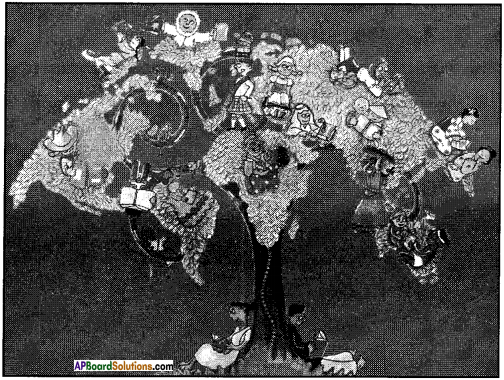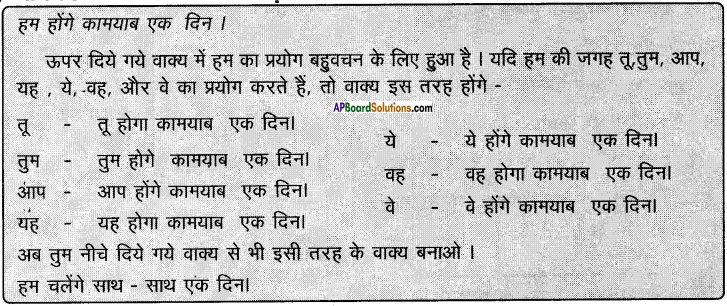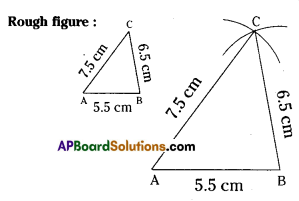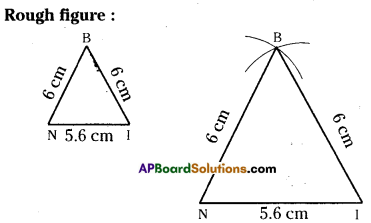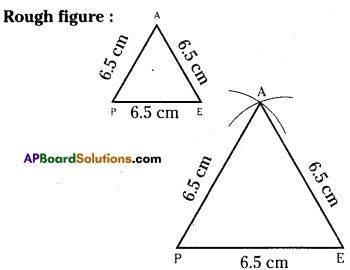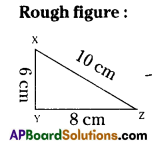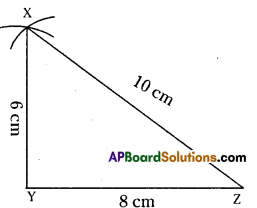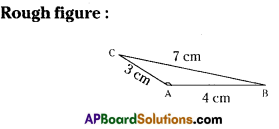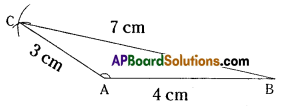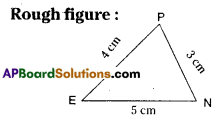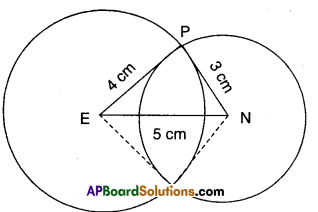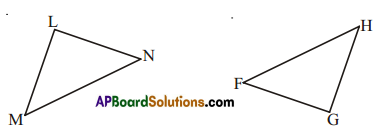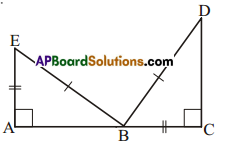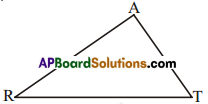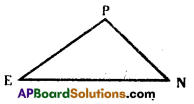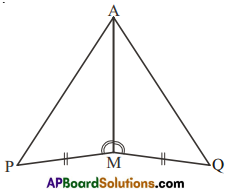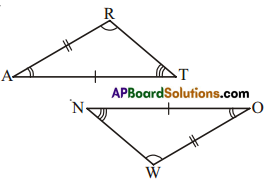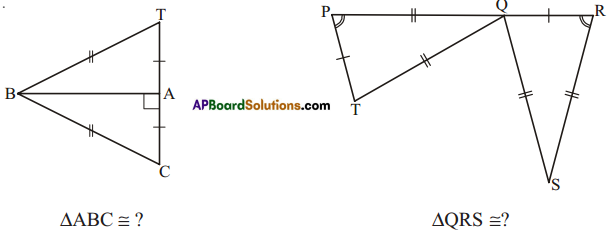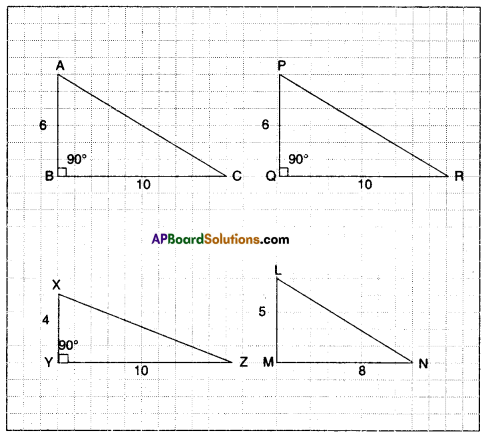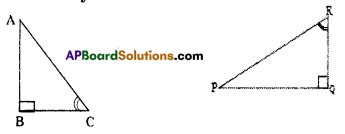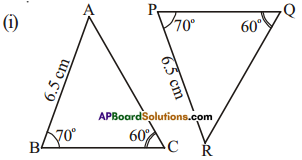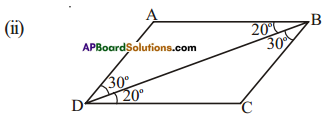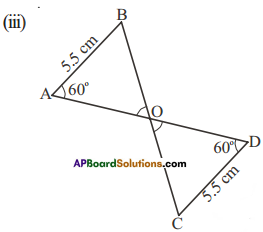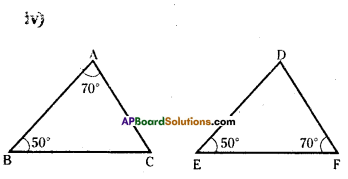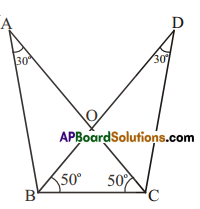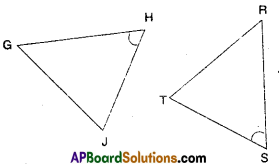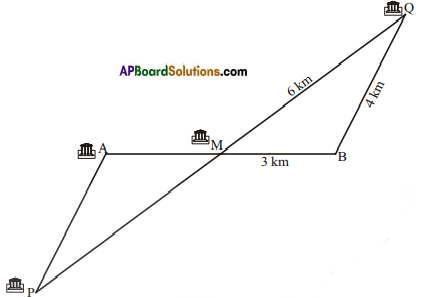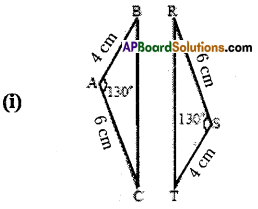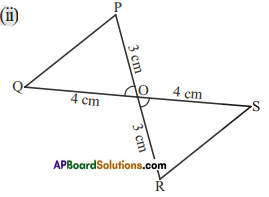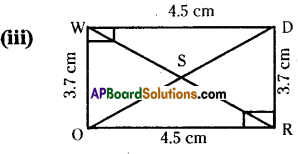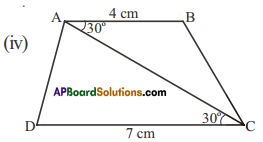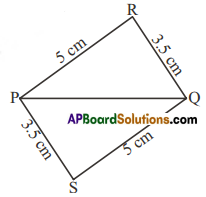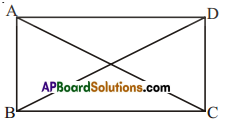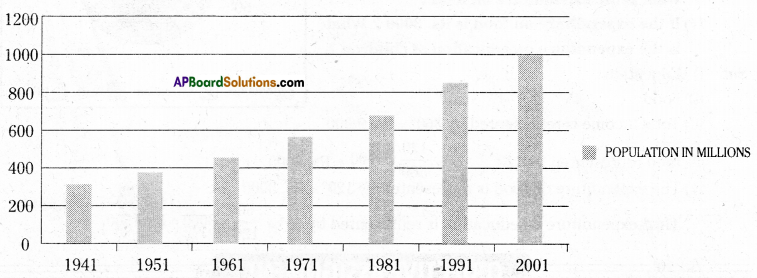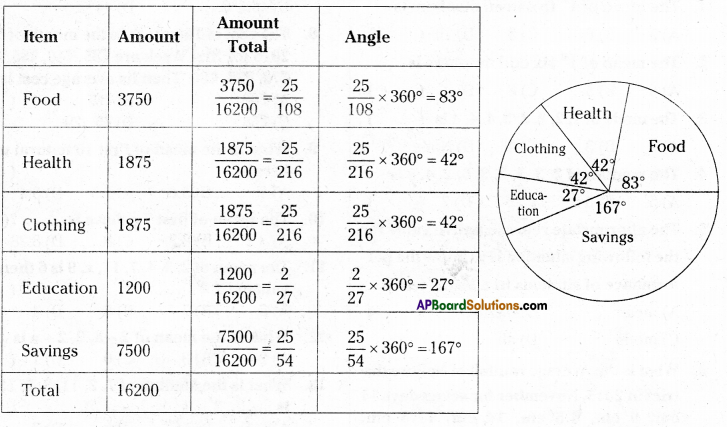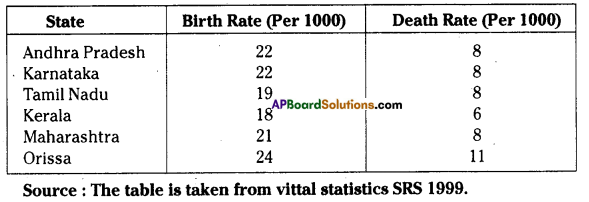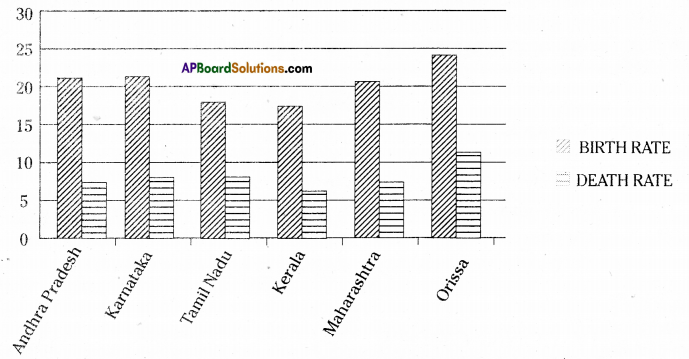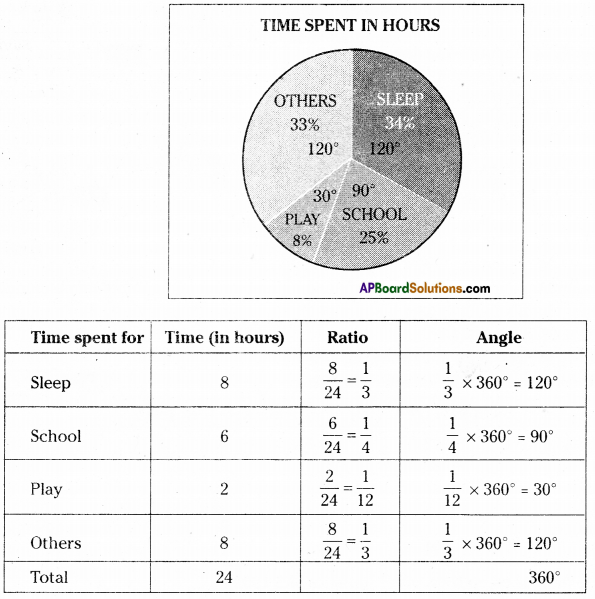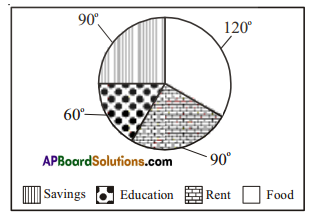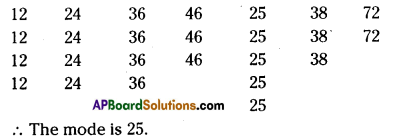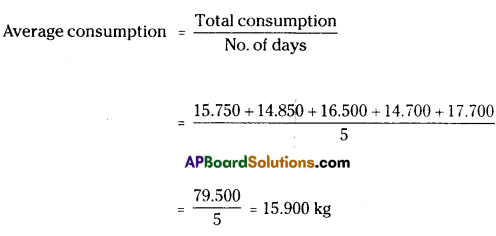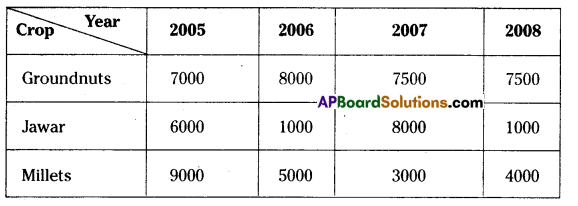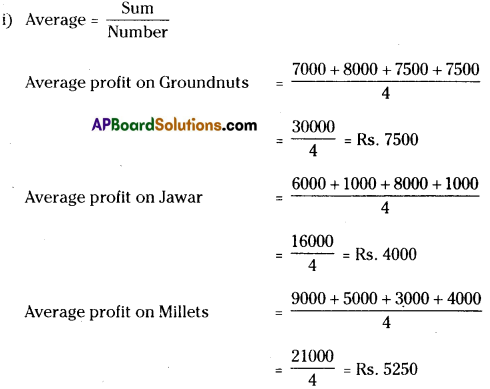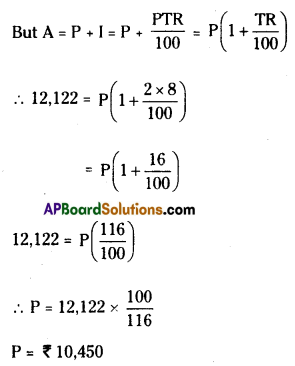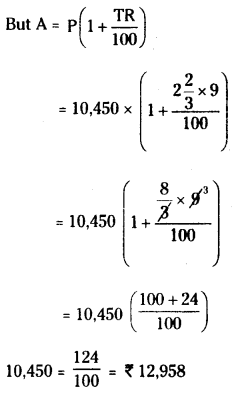AP State Syllabus AP Board 8th Class Hindi Textbook Solutions Chapter 2 राजा बदल गया Textbook Questions and Answers.
AP State Syllabus 8th Class Hindi Solutions Chapter 2 राजा बदल गया
8th Class Hindi Chapter 2 राजा बदल गया Textbook Questions and Answers

प्रश्न 1.
चित्र में क्या – क्या दिखायी दे रहा हैं?
उत्तर:
चित्र में एक लडका, लडके के दाये हाथ में ग्लोब, बाये हाथ में किताब दिखायी दे रहे हैं।
प्रश्न 2.
लडका क्या कर रहा है ?
उत्तर:
लडका खुशी से ग्लोब के देशों को दिखाने के लिए दौडकर आ रहा है।
![]()
प्रश्न 3.
यह लड़का हमें क्या बताना चाहता है?
उत्तर:
यह लड़का हमें बताना चाहता है कि ज्ञान से दुनिया बदल सकते हैं।
सुनो – बोलो
प्रश्न 1.
पाठ में दिये गये चित्रों के बारे में बातचीत करो।
उत्तर:
पाठ में दिये गये चित्रों में पहले चित्र में जंगल का वातावरण दिखायी देता है। रास्ते में एक सोने का सिक्का पड़ा रहता है। एक लडका जाता रहता है। वह सोने का सिक्का देखकर लेता है। और वह एक साधु से मिलता है। । दूसरे चित्र में राजा सैनिकों के साथ आ रहे हैं। लडका राजा को सिक्का दे रहा है।
प्रश्न 2.
इस पाठ का कोई दूसरा नाम क्या हो सकता है?
उत्तर:
इस पाठ का दूसरा नाम “राजा की आँखें खुल गई’ हो सकता है। क्योंकि जब राजेश सोने का सिक्का राजा को देकर मुनि की बातें कहा, तब राजा को अपनी भूल मालूम हुई। इसलिए यह नाम (राजा की आँखें खुल गई) सहमत है ।
प्रश्न 3.
राजेश को जगंल में क्या – क्या दिखायी दिये होंगे?
उत्तर:
राजेश को जंगल में पेड – पौधे, पशु – पक्षी, जानवर, झरने आदि दिखायी दिये होंगे।
प्रश्न 4.
साधु ने सिक्का गरीब को देने के लिए क्यों कहा?
उत्तर:
साधु लोग भिक्षा माँगकर अपने जीवन यापन करते हैं। उनको किसी (दूसरों के) चीज़ पर आशा नहीं होती वे सब कुछ त्यागने से ही साधु बन जाते हैं। साधु परोपकारी होते हैं। इसलिए साधु ने सिक्का गरीब को देने के लिए कहा।
![]()
प्रश्न 5.
अगर हमें किसी की कोई चीज़ मिलती है, तो हम क्या करेंगे?
उत्तर:
अगर हमें पाठशाला में कोई चीज़ मिलती है, तो हम उसे कार्यालय में दे देंगे। सडक पर कोई चीज़
मिली तो हम उसके बारे में पूछ – ताछ करके वह जिसका है उसे दे देंगे।
पढ़ो
अ) “भाई ! आपके राजा इतनी बड़ी सेना लिये कहाँ जा रहे हैं?” यह वाक्य जिस अनुच्छेद में है, उसे पढ़ो और बताओ कि राजेश ने यह वाक्य किस उद्देश्य से कहा?
उत्तर:
यह वाक्य राजेश ने इस उद्देश्य से कहा होगा कि ज़रूर कुछ बात होने से ही राजा अपनी सेना के साथ
जा रहे हैं।
आ) नीचे दिये गये वाक्य पढ़कर पाठ के आधार पर सही क्रम में लिखो ।
1. “लीजिए महाराज! आप इसे रख लीजिए।”
2. “मैं राजा हूँ, राजा! मैं तुझे गरीब लगता हूँ?”
3 “बेटा! मुझे क्यों देना चाहते हो?”
4. “भाई ! आपके राजा इतनी बड़ी सेना लिये कहाँ जा रहे हैं?”
5. “इसे तो किसी गरीब को दे दो ताकि वह अपना पेट भर सके।”
उत्तर:
- “इसे तो किसी गरीब को दे दो ताकि वह अपना पेट भर सके।”
- “भाई ! आपके राजा इतनी बड़ी सेना लिये कहाँ जा रहे हैं?”
- “लीजिए महाराज! आप इसे रख लीजिए।”
- “बेटा! मुझे क्यों देना चाहते हो?”
- “मैं राजा हूँ, राजा! मैं तुझे गरीब लगता हूँ?”
इ) पाठ में सोने के सिक्के के बारे में कहा गया है। उस सिक्के का चित्र बनाओ और दो वाक्य लिखो।
उत्तर:
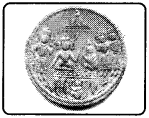
जिस प्रकार आजकल चालू में सिक्के हैं उसी प्रकार प्राचीन काल में सोने के और चाँदी के सिक्के चालू में होते थे । आजकल वे सिक्के बहुमूल्य हैं।
ई) नीचे लिखे प्रश्नों के उत्तर लिखो।
प्रश्न 1.
राजेश कहाँ से जा रहा था?
उत्तर:
राजेश एक बार जंगल से जा रहा था |
![]()
प्रश्न 2.
राजेश ने सोने के सिक्के का क्या किया?
(या)
राजेश को एक सोने का सिक्का मिला। उसने उसका क्या किया?
उत्तर:
राजेश ने सोने के सिक्के को पहले साधु को दिया । साधु ने कहा कि इसे किसी गरीब को दे दो ताकि वह अपना पेट भर सके। तब राजेश ने दूसरी बार उसे राजा को दिया।
प्रश्न 3.
राजा का नाम क्या था? वह कैसा था?
(या)
“राजा बदल गया’ पाठ में राजा का नाम क्या था? वह कैसा था?
उत्तर:
- राजा बदल गया नामक पाठ में राजा का नाम शूरसिंह था।
- वह वीर और शूर था।
- वह दूसरे राज्यों पर आक्रमण करके उन्हें छीन लेता था। और उन्हें लूटता था।
लिखो
अ) नीचे दिये प्रश्नों के उत्तर लिखो।
प्रश्न 1.
किसी पर आक्रमण करना उचित नही हैं। क्यों?
उत्तर:
किसी पर आक्रमण करना उचित नहीं है। क्योंकि हर एक को कुछ अधिकार हैं। इसके अनुसार हर एक को जीने तथा संपत्ति को इकट्ठा करने का अधिकार है | आक्रमण करना जानवरों का काम है। इसीलिए आक्रमण करना अन्याय है।
प्रश्न 2.
राजा का स्वभाव कैसा था? अपने शब्दों में लिखिए |
उत्तर:
राजा तो दयालू, ईमानदार और बुद्धिमान था। अपनी जनता की सुख, समृद्धि और हित ही चाहनेवाला था। लेकिन अज्ञानता के वशीभूत होकर दूसरे देश पर आक्रमण करने निकल पडा। राजेश की बातों से सच्चाई जानकर अपने को बदल दिया। अपनी सारी संपत्ति जनता की सेवा में खर्च करना आरंभ किया।
![]()
आ) “राजा बदल गया’ कहानी अपने शब्दों में लिखो।
(या)
राजेश ने अपनी बातों से राज को बदल दिया था? कैसे?
(या)
राजेश ईमानदार बालक है। उसने राजा में कैसे परिवर्तन लाया ?
(या)
राजेश की बातों से राजा को अपनी गलती का अहसास हुआ । पाठ के आधार पर लिखिए।
उत्तर:
एक बार राजेश नामक एक लड़का जंगल में जा रहा था । रास्ते में उसे एक सोने का सिक्का मिला। वह उसे लेकर सोचने लगा कि “बेचारा किसी ने इसे खोया” | रास्ते में उसे एक साधु मिलने पर सिक्के को साधु को देने से साधु ने कहा कि “बेटा यह सिक्का हमारे जैसे साधुओं के लिए नहीं है इसे तो किसी गरीब को दे दो ताकि वह अपना पेट भर सके।
साधु की बात मानकर चलते समय उसने देखा और पता कर लिया कि ‘शूरसिंह नामक राजा अपनी सेना सहित पडोसी देश पर आक्रमण कर उसे लूटने जा रहे हैं।” राजेश राजा के पास जाकर सिक्का उसे देने की कोशिश की । राजा ने आश्चर्य से पूछा कि ”बेटा मुझे क्यों देना चाहते हो?” तब राजेश ने जवाब दिया कि “साधु ने कहा जो सबसे गरीब दिखे उसे यह सिक्का दे देना” तब राजा क्रोध से बोला ”मैं राजा हूँ, राजा ! क्या मैं तुझे गरीब लगता हूँ?’ तब राजेश ने बताया कि “आप अमीर होते तो दूसरे देश को लूटने के लिए इतनी बड़ी सेना लेकर क्यों जाते?”
राजेश की बातों से राजा की आँखें खुल गई । उसे अपनी गलती मालूम हुई । राजेश की प्रशंसा करके सेना को वापस लौटने का आदेश दिया । उस दिन से राजा ने अपनी संपत्ति गरीबों की सेवा में खर्च करना आरंभ किया ।
शब्द भंडार
अ) उदाहरण देखो और समझो | इसी तरह आगे कुछ शब्द लिखो ।
उदाहरण : सैनिक – कम – मन – नल – लगन

आ) संकेत के आधार पर वाक्य लिखो।
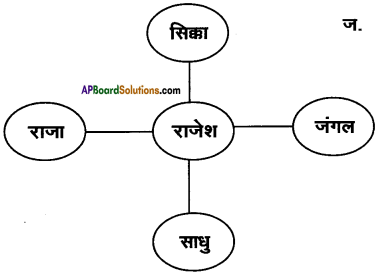
उत्तर:
- राजेश नामक लडका एक दिन जंगल में जा रहा था।
- राजेश को जंगल के रास्ते में एक सोने का सिक्का मिला।
- राजेश सोने के सिक्के को साधु को देने का प्रयत्न किया ।
- अंत में राजेश सोने के सिक्के को राजा को देने साधु की कोशिश की।
इ) नीचे दिये गये शब्द पढ़ो | उनके विलोम शब्द लिखो। वाक्य प्रयोग करो।
| पास बडा गरीब देश |
उदाहरण : पास × दूर मक्का मसजिद, चारमीनार के पास है । बिरला मंदिर दूर है।
बडा × छोटा राम रहीम से बड़ा है । लेकिन करीम से छोटा है।
गरीब × अमीर सुदामा गरीब होने पर भी श्री कृष्ण की करुणा से अमीर बना गया।
देश × विदेश ताजमहल को देखने देश के लोग ही नहीं विदेश के लोग भी आते हैं।
सजनात्मक अभिव्यक्ति
“राजा बदल गया’ कहानी की किसी एक घटना को संवाद रूप में लिखो।
उत्तर:
जंगल में राजेश और साधु के बीच में घटी घटना :
राजेश : (अपने आप में) अरे वाह! इतने घने जंगल में चमकता हआ सोने का सिक्का! किसका होगा? (इतने में एक साधु आ रहे थे ।)
राजेश : प्रणाम साधु महाराज!
साधु : आयुष्मान भव! बेटा! तुम कौन हो ?
राजेश : मेरा नाम राजेश है। मुझे रास्ते में यह सिक्का मिला। यह मेरा नहीं है। आप ले लीजिए।
साधु : अरे बेटा ? मैं तो साधु हूँ। मैं यह सिक्का लेकर क्या करूँगा? तुम ही रास्ते में किसी गरीब आदमी को दे दो। उनके लिए बहुत उपयोग होता है।
राजेश : ठीक है साधु महाराज। मैं वैसा ही करूँगा। प्रणाम!
साधु : जीते रहो बेटा।
प्रशंसा
इस पाठ में राजेश की ईमानदारी के बारे में बताया गया है। ऐसी ही एक और कहानी कक्षा में सुनाओ।
उत्तर:
किसी एक समय की बात है। एक गरीब लकडहारा था। वह बहुत ईमानदार था। वह रोज़ लकडे काटने के लिए जंगल जाया करता था । एक दिन वह पेड की डाली काटने के लिए पेड पर चढ़ा। पेड नदी के किनारे और उसकी डाली नदी पर थी । डाली काटते – काटते अचानक उसकी कुल्हाडी नदी में जा गिरी। वह इस प्रकार रोने लगा कि ”मेरी कुल्हाडी चली गई। नदी तो बहुत गहरी है और मुझे मेरी कुल्हाडी वापस नहीं मिलेगी। मैं क्या करूँ? और अपने परिवार का परिवरिश कैसे करूँ?
लकडहारा निराश होकर पानी की ओर देख रहा था। अचानक एक सुंदर परी नदी से बाहर आई। लकडहारे ने कहा ‘आप कौन हैं?’ परी ने जवाब दिया कि “मैं इस नदी की परी हूँ। “तुम्हारी दुःखी आवाज़ सुनकर बाहर आई हूँ। तुम्हें क्या हुआ है?” लकडहारा सब कुछ साफ़ – साफ़ बताया। परी ने पानी के अंदर जाकर एक चाँदी की कुल्हाडी के साथ बाहर आकर कहा कि क्या यह तुम्हारी कुल्हाडी है? तब लकडहारे ने कहा यह मेरी नहीं है। यह बहुत मूल्यवान है | मेरी तो लकडी की थी। फिर परी अंदर से सोने की कुल्हाडी लाकर दिखाने से लकडहारा नहीं कहा । अंत में लकडी से बनी कुल्हाडी लाकर दिखाने से उसने हाँ कहकर ले लिया। तब परी सोने और चाँदी दोनों को भी लकडहारे को देकर ये तुम्हारे ईमानदारी के फल हैं। इन्हें भी रख लो कहकर परी अंदर चली गई। लकडहारा खुशी से घर लौटा।
“ईमानदारी सबसे बढ़िया है”।
भाषा की बात
अ) नीचे दिये वाक्य पढ़ो |
इतनी बड़ी सेना को देखकर वह सोचने लगा कि ज़रूर कोई बात रही होगी, जो राजा अपनी सेना को लिए जा रहे हैं । उसने एक सैनिक से पूछा – ”भाई ! आपके राजा इतनी बड़ी सेना लिये कहाँ जा रहे हैं?
ऊपर दिये अनुच्छेद में कुछ चिह्न आये हैं, जैसे – (,), (I), (-), (” ”), (!), (?) इन चिह्नों को ‘विराम चिह्न’ (Punctuation) कहते हैं। बोलते अथवा पढ़ते समय अपनी बात को ठीक से कहने के लिए कुछ देर रुकना पड़ता है। रुकने की यह क्रिया व्याकरण की भाषा में “विराम” कहलाती है | कहानी, लेख, निबंध आदि लिखते समय इस प्रकार के रुकने के स्थलों की स्पष्टता के लिए जिन चिह्नों का प्रयोग किया जाता है, उन्हें विराम चिह्न कहते हैं। विराम चिह्नों के उचित प्रयोग से ही भावों में स्पष्टता आती है।
![]()
आ) अब इनमें से जो चिहन पाठ में आये हैं, उन्हें ढूँढकर रेखांकित करो।
उत्तर:
‘ एक बार एक जंगल में राजेश नामक लड़का जा रहा था । रास्ते में उसे एक सोने का सिक्का मिला_|
वह सोचने लगा – “यह सिक्का मेरा तो है ही नहीं, इसे क्या करूँ लेकर … जाने किस बेचारे का सिक्का यहाँ गिर गया है। अब न तो इसे रख ही सकता हूँ और न फेंक सकता हूँ, आखिर सोना जो है’!
यही सब सोचते हुए वह आगे बढ़ा चला जा रहा था। रास्ते में माला जपते हुए एक साधु महाराज से मिले। उसने सोचा क्यों न यह सिक्का साधु को ही दे दूँ!
राजेश ने जब वह सिक्का साधु को दिया तो सोने के सिक्के को देखकर साधु ने आश्चर्य से कहा – “बेटा ! यह सिक्का हमारे जैसे साधुओं के लिए नहीं है। इसे तो किसी गरीब को दे दो ताकि वह अपना पेट भर सके।”
साधु की बात मानकर राजेश आगे चला तो उसने देखा कि किसी राजा की सेना चली जा रही है। इतनी बडी सेना को देखकर वह सोचने लगा कि ज़रूर कोई बात रही होगी, जो राजा अपनी सेना को लिये जा रहे हैं। उसने एक सैनिक से पूछा – “भाई ! आपके राजा इतनी बड़ी सेना लिये कहाँ जा रहे हैं?’
“यह हमारे राजा शूरसिंह हैं, जो पड़ोसी देश पर आक्रमण कर उसे लूटने जा रहे हैं” – उसने जवाब दिया।
राजेश राजा के पास गया। सोने का सिक्का उनकी ओर बढ़ाते हुए कहा – “लीजिए महाराज! आप इसे रख लीजिए।”
“बेटा ! मुझे क्यों देना चाहते हो।” – राजा ने आश्चर्य के साथ पूछा।
परियोजना कार्य
अपनी मनपसंद कहानी कागज़ पर लिखकर दीवार पत्रिका पर चिपकाओ।
उत्तर:
एक तालाब के दलदल में दो मेंढ़क रहते थे। वे दोनों वहाँ बडे आनंद से अपना जीवन बिता रहे थे।
गर्मियों के दिन आये। तालाब का दलदल सूखने लगा। एक दिन वह पूरी तरह सूख गया। मेंढ़कों को विवश होकर वह स्थान छोडना पडा | अपने लिए नया घर ढूँढते-ढूँढते वे दोनों एक कुएँ के निकट आ पहुँचे। कुएँ के किनारे बैठकर उन दोनों ने भीतर की ओर झाँका। कुएँ में पानी ऊपर तक था।
एक मेंढ़क खुशी में झूमता हुआ दूसरे से बोला – भैया देखो इस कुएँ में कितना ऊपर तक पानी है ओर यह हमारे रहने का उचित स्थान है। यह स्थान सुरक्षा की दृष्टि से भी ठीक है। आओ इसके भीतर चलें।
दूसरा मेंढ़क बहुत समझदार था। उसने अपनी बुद्धिमानी का परिचय देते हुए कहा “इतनी शीघ्रता अच्छी नहीं । दलदल सूखने पर हमें पुराना घर छोडना पड़ा | अगर हम यहाँ रहने लगे और कुएँ का पानी सूख गया तो हम बाहर कैसे आयेंगे? दूसरे मेंढ़क की बात सुनकर पहले वाले का सिर शर्म से झुक गया।
शिक्षा :
“कुछ भी करने – कहने से पहले सोच – विचार लें कि ऐसा करने या कहने का नतीजा क्या होगा?’
राजा बदल गया Summary in English
One day a boy named Rajesh was going through a forest. On the way he found a gold coin. He took the coin and began to think about the person who had lost it. He went forward and met a Sage. When he was about to give the coin to the Sage, he told Rajesh that he hadn’t needed the coins (money). He also advised Rajesh to give the coin to any poor man so that he could satisfy his hunger.
Later Rajesh walked farther and met a king named Sursimh. He came to know that the king was going to invade the neighbouring country with his army. Rajesh went to the king and about to give him the coin. The king asked him why he was giving the coin. Rajesh replied that the Sage he met had advised him to give it to the poorest man. The king got angry and asked Rajesh whether he was looking like a poor man. Then Rajesh asked the king why he, being a rich man, was going to plunder the neighbouring country.
The king realised his mistake. He admired Rajesh and ordered the army to go back. From that day onwards, he began to help the poor with his wealth.
अर्थग्राह्यता - प्रतिक्रिया
पठित- गद्यांश
नीचे दिये गये गद्यांश को पढ़कर प्रश्नों के उत्तर एक वाक्य में लिखिए।
1. राजेश राजा के पास गया। सोने का सिक्का उनकी ओर बढ़ाते हुए कहा - ”लीजिए महाराज आप इसे रख लीजिए।”
“बेटा ! मुझे क्यों देना चाहते हो ?” - राजा ने आश्चर्य के साथ पूछा ।
प्रश्न :
1. राजा के पास कौन गया?
उत्तर:
राजेश राजा के पास गया ।
(या)
राजा के पास राजेश गया।
2. राजेश ने सोने का सिक्का राजा की ओर बढ़ाते हुए क्या कहा?
उत्तर:
राजेश ने सोने का सिक्का राजा की ओर बढ़ाते हुए कहा ”लीजिए महाराज ! आप इसे रख लीजिए।”
3. राजा ने आश्चर्य के साथ क्या पूछा?
उत्तर:
राजा ने आश्चर्य के साथ पूछा ”बेटा ! मुझे क्यों देना चाहते हो ?’
4. राजा का नाम क्या था?
उत्तर:
राजा का नाम था ”शूरसिंह”|
5. आश्चर्य शब्द का पर्याय लिखिए।
उत्तर:
आश्चर्य शब्द का पर्याय है ”अचरज”।
![]()
2. यही सब सोचते हुए वह आगे बढ़ा चला जा रहा था। रास्ते में माला जपते हुए एक साधु महाराज उसे मिले। उसने सोचा, क्यों न यह सिक्का साधु को ही दे दूं।
राजेश ने जब वह सिक्का साधु को दिया तो सोने के सिक्के को देखकर साधु ने आश्चर्य से कहा - ”बेटा ! यह सिक्का हमारे जैसे साधुओं के लिए नहीं है। इसे तो किसी गरीब को दे दो ताकि वह अपना पेट भर सकें।”
प्रश्न :
1. राजेश को रास्ते में माला जपते हुए कौन मिले?
उत्तर:
राजेश को रास्ते में माला जपते हुए एक साधु महाराज मिले।
2. सोने के सिक्के को देखकर साधु ने आश्चर्य से क्या कहा?
उत्तर:
सोने के सिक्के को देखकर साधु ने आश्चर्य से कहा ”बेटा ! यह सिक्का हमारे जैसे साधुओं के लिए नहीं हैं। इसे तो किसी गरीब को दे दो ताकि वह अपना पेट भर सकें।”
3. राजेश ने सिक्के को किसे दिया?
उत्तर:
राजेश ने सिक्के को एक साधु महाराज को दिया।
4. राजेश ने क्या सोचा?
उत्तर:
राजेश ने सोचा कि क्यों न यह सिक्का साधु को ही दे दूँ।
5. ’गरीब’ शब्द का विलोम शब्द लिखिए।
उत्तर:
गरीब शब्द का विलोम शब्द है ”अमीर”।
![]()
3. साधु की बात मानकर राजेश आगे चला तो उसने देखा कि किसी राजा की सेना चली जा रही है। इतनी बड़ी सेना को देखकर वह सोचने लगा कि ज़रूर कोई बात रही होगी, जो राजा | ’अपनी सेना लिये जा रहे हैं। उसने एक सैनिक से पूछा - ”भाई ! आपके राजा इतनी बड़ी सेना लिये कहाँ जा रहे हैं?”
प्रश्न :
1. राजेश ने क्या देखा?
उत्तर:
राजेश ने देखा कि किसी राजा की सेना चली जा रही है।
2. राजेश ने एक सैनिक से क्या पूछा?
उत्तर:
राजेश ने एक सैनिक से पूछा - ”भाई ! आपके राजा इतनी बड़ी सेना लिये कहाँ जा रहे हैं।”
3. बडी सेना को देखकर राजेश क्या सोचने लगा?
उत्तर:
बड़ी सेना को देखकर राजेश सोचने लगा कि ज़रूर कोई बात रही होगी, जो राजा अपनी सेना लिये जा रहे हैं।
4. राजेश किसकी बात मानकर आगे चला?
उत्तर:
राजेश साधु की बात मानकर आगे चला।
5. उपर्युक्त गद्यांश किस पाठ से दिया गया है?
उत्तर:
उपर्युक्त गद्यांश ’राजा बदल गया’ पाठ से दिया गया है।
![]()
4. एक लड़का था। उसका नाम राजेश था। वह जंगल में जा रहा था। रास्ते में उसे एक सोने का सिक्का मिला । वह सोचने लगा - “यह सिक्का मेरा तो है ही नहीं, इसे क्या करूँ लेकर …. जाने किस बेचारे का सिक्का यहाँ गिर गया है। अब न तो इसे रख सकता है और न ही फेंक सकता हूँ, क्या करूँ इसका ?”
प्रश्न :
1. लडके का नाम क्या था?
उत्तर:
लडके का नाम राजेश था।
2. रास्ते में उसे क्या मिला?
उत्तर:
रास्ते में उसे एक सोने का सिक्का मिला |
3. जंगल मे कौन जा रहा था?
उत्तर:
जंगल में राजेश जा रहा था ।
4. सोने के सिक्के को देखकर राजेश क्या सोचने लगा?
उत्तर:
सोने के सिक्के को देखकर राजेश सोचने लगा - ”यह सिक्का मेरा तो है ही नहीं, इसे क्या करूँ लेकर …. जाने किस बेचारे का सिक्का यहाँ गिर गया है। अब न तो इसे रख सकता हूँ और न ही फेंक सकता हूँ। क्या करूँ इसका?”
5. उपर्युक्त गद्यांश किस पाठ से दिया गया है?
उत्तर:
उपर्युक्त गद्यांश ’राजा बदल गया’ पाठ से दिया गया है।
![]()
5. ”महाराज ! एक साधु ने कहा था कि जो सबसे गरीब दिखे उसे यह सिक्का दे देना।” - राजेश करुण स्वर में बोला। ”मैं राजा हूँ, राजा ! मैं तुझे गरीब लगता हूँ?” - राजा क्रोध में बोला। ”महाराज ! यदि आप अमीर होते तो दूसरे देश को लूटने के लिए इतनी बड़ी सेना लेकर क्यों जाते?”
प्रश्न :
1. राजेश करुण स्वर में क्या बोला?
उत्तर:
राजेश करुण स्वर में बोला ”महाराज ! एक साधु ने कहा था कि जो सब से गरीब दिखे उसे यह सिक्का दे देना।”
2. राजा क्रोध में क्या बोला?
उत्तर:
राजा क्रोध में बोला ”मैं राजा हूँ, राजा ! मैं तुझे गरीब लगता हूँ?”
3. साधु ने क्या कहा था?
उत्तर:
साधु ने कहा था कि ”जो सब से गरीब दिखे उसे यह सिक्का दे देना।”
4. ”अमीर” शब्द का विलोम शब्द क्या है?
उत्तर:
अमीर शब्द का विलोम है ”गरीब”।
5. उपर्युक्त यह गद्यांश किस पाठ से दिया गया है?
उत्तर:
उपर्युक्त यह गद्यांश ‘राजा बदल गया’ पाठ से दिया गया है।
![]()
6. राजेश की बात राजा की समझ में आ गयी। उन्हें अपनी गलती का अहसास हुआ। राजेश की प्रशंसा करते हुए उन्होंने सेना को वापस लौटने का आदेश दिया। उस दिन से राजा ने अपनी संपत्ति जनता की सेवा में खर्च करना आरंभ कर दिया।
प्रश्न :
1. राजेश की बात किनकी समझ में आ गयी?
उत्तर:
राजेश की बात राजा की समझ में आ गयी।
2. किसे अपनी गलती का आहसास हुआ?
उत्तर:
राजा को अपनी ग़लती का अहसास हुआ।
3. राजा ने सेना को क्या आदेश दिया?
उत्तर:
राजा ने सेना को वापस लौटने का आदेश दिया।
4. राजा ने किसकी प्रशंसा की?
उत्तर:
राजा ने राजेश की प्रशंसा की।
5. उस दिन से राजा ने क्या करना आरंभ कर दिया?
उत्तर:
उस दिन से राजा ने अपनी संपत्ति जनता की सेवा में खर्च करना आरंभ कर दिया।
अपठित - गद्यांश
निम्न लिखित गद्यांश पढ़कर दिये गये प्रश्नों के उत्तर विकल्पों में से चुनकर लिखिए।
1. प्रिये, घबराओ नहीं। इस मुद्रिका पर मेरे नाम के जितने अक्षर हैं उतने ही दिनों में मेरे कर्मचारी आकर तुम्हें अंतःपुर में पहुँचाएँगे। मुद्रिका देखते ही मैं भी तुम्हें पहचान सकूँगा। दुष्यंत चला गया और फिर उसने गर्भवती शकुन्तला की सुध नहीं ली। शकुन्तला प्रिय वियोग से व्याकुल होकर अपनी सुधबुध खो गयी। दुर्दैव से एक दिन क्रोधी दुर्वास का आगमन हुआ और उन्हें आतिथ्य देने में शकुन्तला दत्तचित नहीं हो सकी। क्रोध में आकर दुर्वास बोले - जिस प्रेमी के ध्यान में पडकर तुम कर्तव्य भूल गयी हो, वह तुम्हें भूल जाएगा। शकुन्तला को इस कठोर वचन की भी सुध न रही। उस समय कण्व सोमतीर्थ गये हुए थे। उनको तो यह वृत्तान्त बिलकुल ज्ञात न था ।
प्रश्न :
1. प्रिय वियोग से व्याकुल होकर कौन अपनी सुधबुध खो गयी थी?
A) दुष्यंत
B) शकुंतला
C) रेणुका
D) जानकी
उत्तर:
B) शकुंतला
2. शकुंतला का प्रिय कौन है?
A) दुष्यंत
B) विश्वामित्र
C) कण्व
D) वशिष्ठ
उत्तर:
A) दुष्यंत
3. दुर्देव से शकुंतला के पास किनका आगमन हुआ?
A) विश्वामित्र
B) वशिष्ठ
C) दुर्वास
D) दुष्यंत
उत्तर:
C) दुर्वास
4. उस समय कण्व कहाँ गये थे?
A) तिरुपति
B) उज्जैयनी
C) भद्राचलम
D) सोमतीर्थ
उत्तर:
D) सोमतीर्थ
5. यह वृत्तांत किन्हें बिलकुल ज्ञात न था?
A) दुर्वास
B) कण्व
C) दुष्यंत
D) वशिष्ठ
उत्तर:
B) कण्व
![]()
2. वरदराज एकदम मंदबुद्धि था। उसे कुछ भी याद नहीं रहता था। उसके सहपाठी आगे बढ़ जाते थे। वह एक साल की पढ़ाई में तीन - तीन साल लगाता रहा । सहपाठी उसका मज़ाक उड़ाते थे। कोई उसे बुद्धू कहता तो कोई मूर्खराज। कोई कहता - “जब ब्रह्मा बुद्धि बाँट रहे थे तब यह सोया हुआ था” कुछ वर्ष बीते।
प्रश्न :
1. वरदराज कैसा लडका था?
A) चालाक
B) होशियार
C) मंदबुद्धि
D) तेज़
उत्तर:
C) मंदबुद्धि
2. कौन आगे बढ़ जाते थे?
A) सहपाठी
B) मित्र
C) भाई
D) पिता
उत्तर:
A) सहपाठी
3. एक साल की पढ़ाई तीन - तीन साल लगाने वाला कौन है?
A) वरदराज
B) राज
C) सहपाठी
D) ब्रह्मा
उत्तर:
A) वरदराज
4. सहपाठी किनका मज़ाक उडाते थे?
A) अध्यापक का
B) मूर्खराज का
C) वरदराज का
D) मित्र का
उत्तर:
C) वरदराज का
5. सहपाठी वरदराज को क्या कहकर मज़ाक उडाते थे?
A) बुद्धू या मूर्खराज
B) चालाक
C) ब्रह्मा
D) बुद्धू
उत्तर:
A) बुद्धू या मूर्खराज
![]()
3. सन् 1912 में अंबेड्कर बी.ए. पास हुए। बरोडा महाराज श्री सयाजीराव गैक्वाड उनकी प्रतिभा से प्रभावित हुए। उच्च शिक्षा के लिए उन्होंने अंबेडकर को अमेरिका भेजा। वहाँ से अंबेड्कर ने एम.ए. की उपाधि ली बाद में पी.हेच.डी. की उपाधि भी। आप भारत लौटकर बरोडा महाराज के सैनिक सचिव पद पर नियुक्त हुए।
प्रश्न :
1. अंबेड्कर बी.ए. कब पास हुए?
A) सन् 1912 में
B) सन् 1921 में
C) सन् 1932 में
D) सन् 1920 में
उत्तर:
A) सन् 1912 में
2. बरोडा महाराज कौन थे?
A) रामाराव
B) श्री सयाजीरा गैक्वाड
C) मालोजी राव
D) बाजीराव
उत्तर:
B) श्री सयाजीरा गैक्वाड
3. अंबेडकर ने क्या - कया उपाधियाँ ली?
A) एम.ए., पी. हेच.डी.
B) एम.ए., बी.ए.
C) बी.ए., बी.एस. सी
D) एम. काम
उत्तर:
A) एम.ए., पी. हेच.डी.
4. उच्च शिक्षा के लिए अंबेडकर को अमेरिका किसने भेजा?
A) शिवाजी
B) महाराणा
C) प्रातपरुद्र
D) श्री सयजीराव गैक्वाड
उत्तर:
D) श्री सयजीराव गैक्वाड
5. अंबेड्कर भारत लौटकर किस पद पर नियुक्त हुए?
A) सैनिक सचिव
B) मुख्यमंत्री
C) प्रधानमंत्री
D) मंत्री
उत्तर:
A) सैनिक सचिव
![]()
4. हिमालय सबसे ऊँचे और बड़े पर्वत हैं। वे हमारे देश की उत्तरी सीमा पर हैं। ये बहुत सुंदर और हमेशा बर्फ से ढके रहते हैं। ये भारतीयों के लिए पवित्र हैं। वहाँ से ही गंगा, जमुना, ब्रह्मापुत्रा आदि जीव - नदियाँ निकलती हैं। विश्व में सबसे ऊँचा पहाड़ ‘एवरेस्ट’ हिमालय में हैं।
प्रश्न :
1. सबसे ऊँचे और बड़े पर्वत क्या है?
A) विध्या
B) सात्पुरा
C) हिमालय
D) कांचन
उत्तर:
C) हिमालय
2. भारतीयों के लिए पवित्र क्या है?
A) हिमालय
B) अरुणाचल
C) सात्पुरा
D) विंध्या
उत्तर:
A) हिमालय
3. हिमालय पर्वतों से क्या - क्या जीव नदियाँ निकली हैं?
A) कृष्णा, गंगा
B) गंगा, गोदावरी
C) गंगा, जमुना, ब्रह्मपुत्रा
D) जमुना, गोदावरी
उत्तर:
C) गंगा, जमुना, ब्रह्मपुत्रा
4. विश्व में सबसे ऊँचा पहाड क्या है?
A)K2
B) एवरेस्ट
C) नीलगिरि
D) नल्लमला
उत्तर:
B) एवरेस्ट
5. उपर्युक्त गद्यांश के लिए उचित शीर्षक क्या हो सकता है?
A) गंगा
B) जमुना
C) एवरेस्टउत्तर:
D) हिमालय
उत्तर:
D) हिमालय
